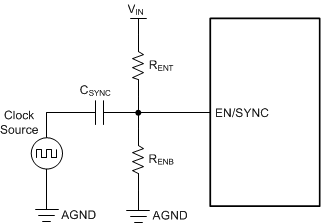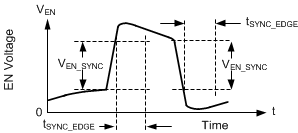SNVSBY6 October 2021 LM61430-Q1
PRODUCTION DATA
- 1 Features
- 2 Applications
- 3 Description
- 4 Revision History
- 5 Device Comparison Table
- 6 Pin Configuration and Functions
- 7 Specifications
-
8 Detailed Description
- 8.1 Overview
- 8.2 Functional Block Diagram
- 8.3
Feature Description
- 8.3.1 EN/SYNC Uses for Enable and VIN UVLO
- 8.3.2 EN/SYNC Pin Uses for Synchronization
- 8.3.3 Clock Locking
- 8.3.4 Adjustable Switching Frequency
- 8.3.5 PGOOD Output Operation
- 8.3.6 Internal LDO, VCC UVLO, and BIAS Input
- 8.3.7 Bootstrap Voltage and VCBOOT-UVLO (CBOOT Pin)
- 8.3.8 Adjustable SW Node Slew Rate
- 8.3.9 Spread Spectrum
- 8.3.10 Soft Start and Recovery From Dropout
- 8.3.11 Output Voltage Setting
- 8.3.12 Overcurrent and Short Circuit Protection
- 8.3.13 Thermal Shutdown
- 8.3.14 Input Supply Current
- 8.4 Device Functional Modes
- 9 Application and Implementation
- 10Power Supply Recommendations
- 11Layout
- 12Device and Documentation Support
- 13Mechanical, Packaging, and Orderable Information
Package Options
Mechanical Data (Package|Pins)
- RJR|14
Thermal pad, mechanical data (Package|Pins)
Orderable Information
8.3.2 EN/SYNC Pin Uses for Synchronization
The LM61430-Q1 EN/SYNC pin can be used to synchronize the internal oscillator to an external clock. The internal oscillator can be synchronized by AC coupling a positive clock edge into the EN pin, as shown in Figure 8-2. It is recommended to keep the parallel combination value of RENT and RENB in the 100-kΩ range. RENT is required for synchronization, but RENB can be left unmounted. Switching action can be synchronized to an external clock ranging from 200 kHz to 2.2 MHz. The external clock must be off before start-up to allow proper start-up sequencing.
 Figure 8-2 Typical Implementation Allowing Synchronization Using the EN Pin
Figure 8-2 Typical Implementation Allowing Synchronization Using the EN PinReferring to Figure 8-3, the AC-coupled voltage edge at the EN pin must exceed the SYNC amplitude threshold, VEN_SYNC_MIN, to trip the internal synchronization pulse detector. In addition, the minimum EN/SYNC rising pulse and falling pulse durations must be longer than tSYNC_EDGE(MIN) and shorter than the blanking time tB. A 3.3-V or higher amplitude pulse signal coupled through a 1-nF capacitor, CSYNC, is suggested.
 Figure 8-3 Typical SYNC/EN Waveform
Figure 8-3 Typical SYNC/EN WaveformAfter a valid synchronization signal is applied for 2048 cycles, the clock frequency abruptly changes to that of the applied signal.